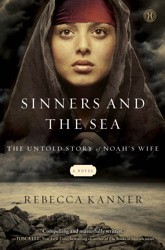 Rebecca Kanner’s Sinners and the Sea, which is scheduled to be published on April 2, is a look at the Torah story of Noah through the eyes of his wife. Thus, it follows a long tradition of fleshing out the details of characters and events that are mentioned in the Torah by filling in the gaps using one’s imagination.
Rebecca Kanner’s Sinners and the Sea, which is scheduled to be published on April 2, is a look at the Torah story of Noah through the eyes of his wife. Thus, it follows a long tradition of fleshing out the details of characters and events that are mentioned in the Torah by filling in the gaps using one’s imagination.
The Torah says almost nothing about Noah’s wife; it just says God told Noah to build the ark and to bring along, in addition to the animals, his wife as well as his sons and their wives. The Torah names the sons, but not Noah’s wife or the wives of his sons.
“Sinners and the Sea” begins by telling us about Noah’s wife’s early life. Kanner deftly chooses not to give Noah’s wife a name, either. Instead, Noah’s wife spends the book wishing for a name, and being disappointed when the men in her life won’t give one to her. Instead, her existence is defined in terms of her relationships with men: daughter, wife, and then mother.
Interestingly, Kanner imagines that at the time God tells Noah to build the ark and to bring along his wife, sons, and their wives, none of his sons are yet married. Therefore, part of the action involves the efforts of both Noah and his wife to obtain wives for their sons before it is too late.
Kanner fleshes out the personalities of the three sons, as well as Noah’s wife. Somewhat disconcertingly, however, she makes out Japheth to be the bad, bloodthirsty son, and makes Ham out to be quite likeable. This was surprising to me, since, in the Torah, it is Ham who is the bad son, seeing his father’s nakedness and being cursed to be the patriarch of Canaan.
The story takes an amusing turn, as local villagers steal the materials that Noah gathers to build the ark. It seems every time he turns around, the locals are either taunting him, stealing from him, or both.
There are also several quite brutal passages, including the scenes when the flood begins and the formerly incredulous villagers are now desperately trying to get onto the ark in order to avoid being drowned. No matter how pitifully they beg and plead, Noah is adamant that no more will be allowed on board than those whom God decreed and of whom he, Noah, approves. This, even if it may mean he will remain short a wife for one of his sons.
Even after the flood causes the ark to float away, Kanner, surprisingly, imagines encounters with others who have not been drowned. I didn’t understand the purpose of this, other than to allow for additional cruel and brutal scenes. In the end, of course, only Noah and his family survive.
I was a bit disappointed that Kanner did not address at all the part of the Torah story in which Noah gets drunk and Ham sees him naked. I also didn’t understand the purpose of the story Kanner chooses to add about the first baby born to one of Noah’s sons. I won’t spoil the surprise by describing the scene here, but if you read the book, you’ll know the one I’m talking about.
Because of some of its idiosyncrasies, such as the elevation of Ham to “good guy” status, Noah’s cruelty, and the details of Noah’s first grandchild, I don’t think this book will ever be considered as Midrash. However, it is an interesting read.
*Sinners and the Sea will be published April 2nd, 2013. Rebecca Kanner is a Twin Cities native. She will be reading from her book and answering questions on April 2nd at 7:30pm at Magers & Quinn in Uptown (3038 Hennepin Ave.).

